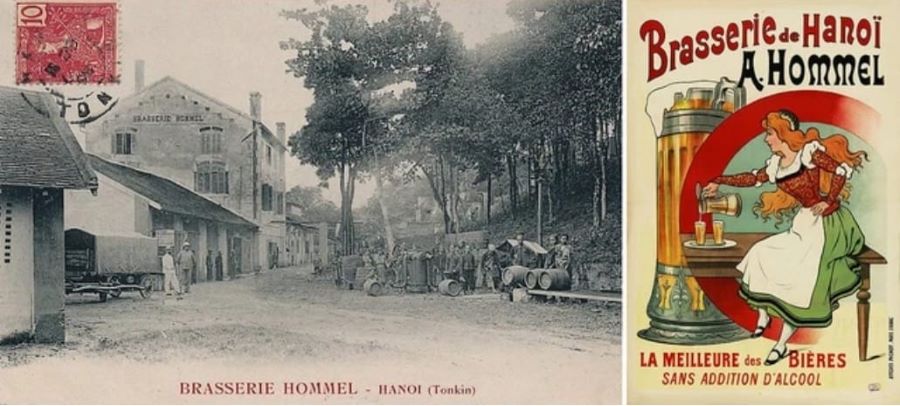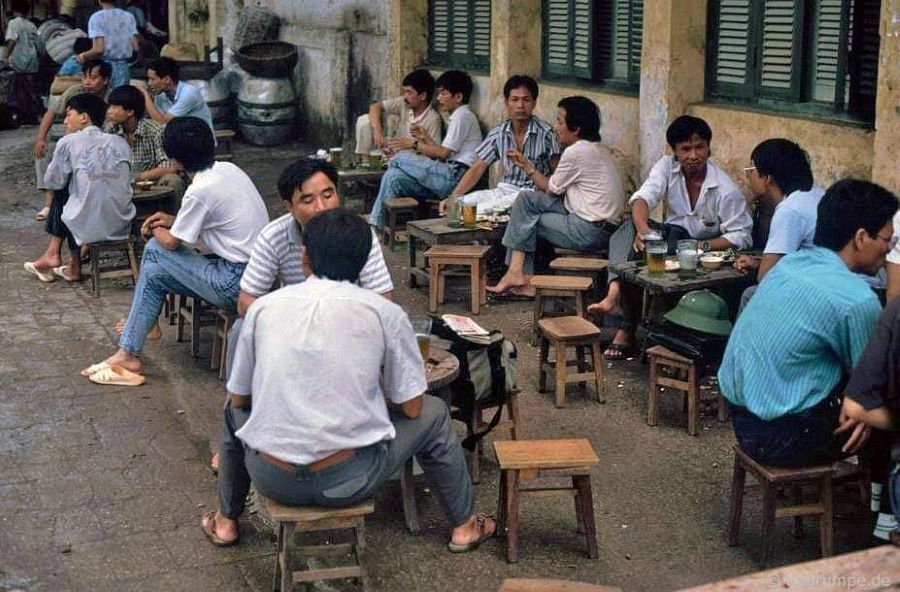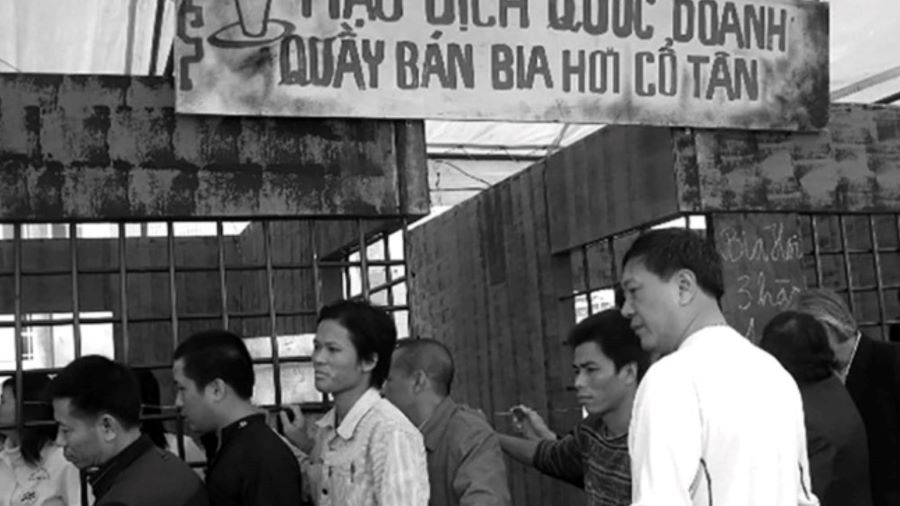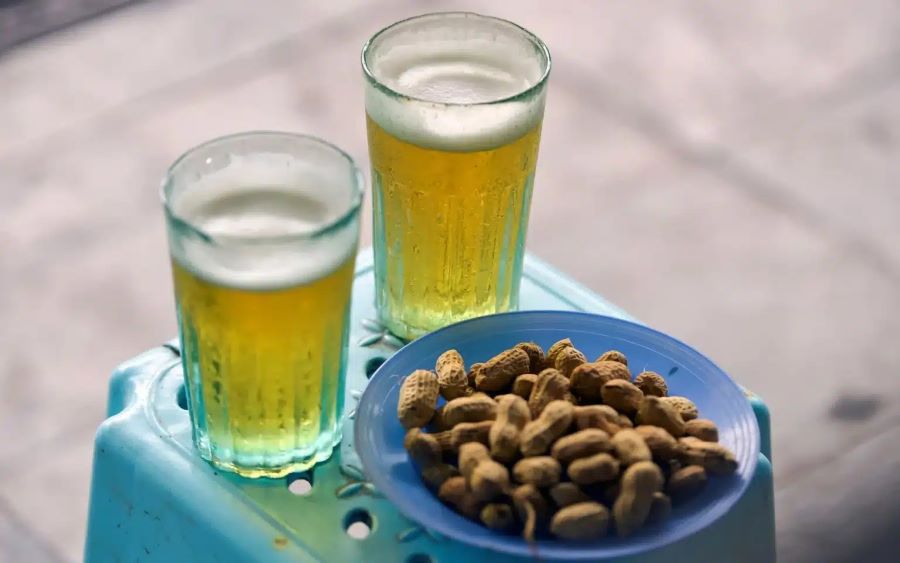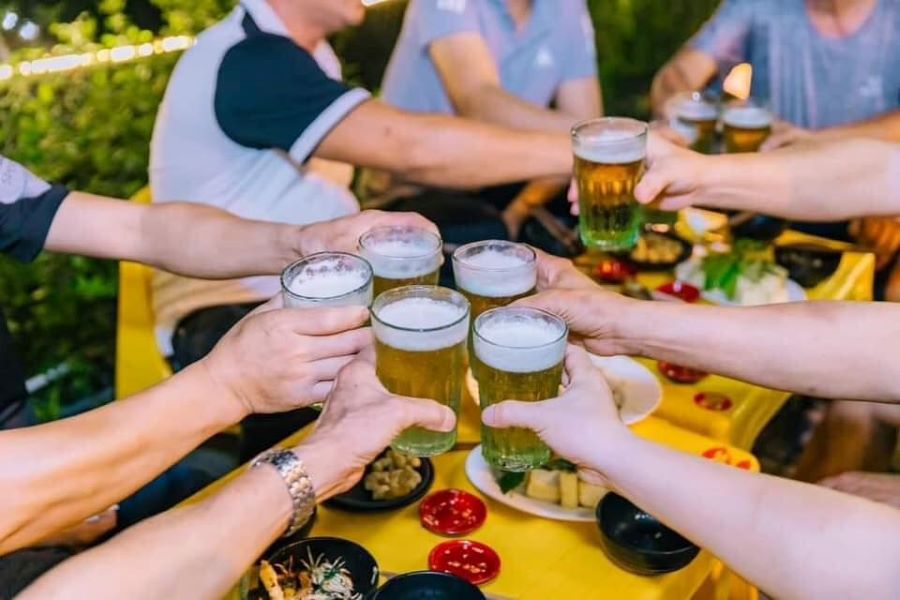
It may come as a surprise to foreign visitors to Hanoi that the locals still like to drink draught beer from plain, ugly glass mugs, even in these days of the proliferation of all kinds of beer, home-brewed, manufactured, and imported. Let's learn about the origins of this distinctive Hanoi beverage with The Hanoi Times.
| Drinking bia hoi, or draught beer, has been a tradition in Hanoi for a long time. Photo: Tinhte |
Having made their debut in Hanoi almost half a century ago, the coarse mugs can still be found in beer restaurants today. For seasoned drinkers who have been around since the subsidy era, these cups are an indispensable part of the capital's standard draught beer set.
When did bia hoi Hanoi come into being?
Bia hoi or draught beer Hanoi has a long history, dating back to the French colonial period in the early 20th century. In 1890, the first brewery in Hanoi was built by French merchant Alfred Hommel on Elephant Mountain in what is now the Botanical Garden. It had a production capacity of 150 liters per day and catered to the beer demands of the French army and civil servants in Hanoi. The beer was bottled in glass and sealed with corks.
The brewery closed down in 1954 but was revived in 1958 with the help of Czech experts. Since its inception, Hanoi Brewery has been located at No. 183 Hoang Hoa Tham.
| The first-ever beer factory in Vietnam was founded by French merchant Alfred Hommel in Hanoi. |
The beer is usually brewed daily and served in local establishments, often in small, casual bars or street stalls. Bia hoi has become a quintessential Hanoi drink, enjoyed by locals and visitors alike.
Bia hoi in the subsidy era
During the subsidy era, the state was in control of many sectors of the economy, including food and beverages and, of course, draught beer, which was always the most popular soft drink. Every morning, dozens of cyclos would be parked in front of the Hanoi Beer Brewery, the predecessor of the Hanoi Beer, Alcohol and Beverage Joint Stock Corporation or HABECO, on Hoang Hoa Tham Street, waiting to be loaded with beer barrels.
Then, one by one, they rushed out of the gate as the cyclo drivers bent their backs and pedaled furiously towards the beer gardens.
In the middle of the sweltering month of May, beer lovers queued up at the state beer stands. As for soft drinks, there was only one type, a purple-red syrup mixed in an aluminum barrel. Once the syrup was poured into cups with an aluminum ladle and a few ice cubes, the vendors would usually let the customers stand around and enjoy their drinks. Others sat at tables inside, often sipping iced coffee from glass cups that they stirred with chopsticks to dissolve the sugar.
At first, the stalls gave customers aluminum spoons, but they lost a lot. Eventually, they couldn't help but replace the spoons with chopsticks. As for the draught beer, at first, it only appealed to a few alcoholics, but later young people and women became 'addicted'.
| A sidewalk beer bar in Hanoi during the subsidized era. Photo: Hans Peter Grumpe |
On Truong Dinh Street in Hai Ba Trung District, there used to be a very large glass-blowing factory that supplied beer cups to restaurants. The mug has a volume of 300ml and is made of composite glass with a white or light green color, with glass bubbles 'floating' on the surface. For decades, Hanoi's draft beer lovers have become so accustomed to these clumsy cups that the drink only tastes good to them... in this kind of container. Seeing such a cup reminds them of beer, and seeing beer reminds them of the cups.
During the subsidy years, the city had a number of state-run beer stalls, which were so popular that customers had to arrive early to get a ticket and then queue for their turn. Back then, such stalls were often located in flower gardens, the busiest being Co Tan Flower Garden next to the Hanoi Opera, Quan Thanh Flower Garden, Nha Ken Flower Garden, or the current Ly Thai To Flower Garden, at the corner of Tho Nhuom and Ly Thuong Kiet streets, among others.
Usually, at two o'clock in the afternoon, cyclists would transport kegs of beer to beer stalls and gardens. There, the salad ladies would wear white aprons emblazoned with the four blue letters MDQD - short for 'State Trading' in Vietnamese. Next to them would be an aluminum barrel of about 200 liters, used to siphon beer from the kegs. At the back, a glass cabinet would contain savory items such as peanuts, fried tofu, fermented pork buns, and sometimes boiled pork intestines...
| Customers queue to buy beer at a beer stand in Hanoi during the subsidized era. Photo: Hans Peter Grumpe |
Even before the beer cyclos reached the stands, eager patrons had already formed a queue five meters long, holding plastic canisters, aluminum kettles, or iced thermos flasks. After showing their coupons and getting their beer, they exited through another door.
As the beer buyers lined up between blue iron railings, the drink was jokingly nicknamed 'tiger cage beer'. As soon as the cyclo drivers dumped the kegs, the 'tiger cage' became as chaotic as a market. Despite the queue, fights would break out simply because someone cut in line.
Hanoian old habit: drinking bia hoi with peanuts
In front of the beer stall was a sign with prices written in white chalk: "Hanoi draft beer: VND10,000 or US$0.4/glass", "Boiled peanuts: VND5,000 or $0.2/ plate", "Fried tofu: VND5,000 or $0.2/ plate".
The staff would take the coupons and spear them on an iron spike, then use an aluminum cup to scoop the beer from the keg into mugs. The way they poured the beer was also very 'professional': just raise your hand a little too high and the mug would overflow with white foam.
| The tradition of drinking beer with boiled peanuts is still very popular in Hanoi. Photo: Tinhte |
As the foam dissipated, the beer would never reach the top of the mug. In the eyes of long-time draught beer drinkers, this was a 'trick' to have a dozen liters left over to share at the end of their shift.
After receiving their orders, customers would carry the mugs to the wooden tables to enjoy the beer with some roasted peanuts brought from home, or buy a toasted rice cracker that sold like hot cakes on the grass. In beer gardens, there were always vendors selling savories, mostly fried tofu, grilled squid, yellow striped scad, papaya salad, Chinese sausages, roasted rice crackers, peanuts, and so on. Beer drinkers would sit on the grass and drink while waiting for the savories.
At times, when there were too many orders for fried tofu, some customers couldn't wait and had to eat raw tofu dipped in shrimp paste. But not everyone sat there drinking beer - many brought kettles and thermos flasks to take home. Because each person was only allowed to buy two mugs, if you wanted to drink more, you had to accept buying beer with peanuts, fried tofu, or pork intestines. In this case, the whole family could feast together.
| A sidewalk beer bar is a popular meeting place for Hanoi residents. Photo: Ha Thu |
On the other hand, the scene of drinking draught beer and eating savory food in flower gardens and on lawns caused great aesthetic problems. The gastronomic culture of the people of Hanoi was being spoiled, and environmental hygiene was an issue that neighborhood associations regularly reminded their residents of.
Many families living next to the beer gardens couldn't stand the stench, and the main culprits were the 'beer gods' who would sit there from early afternoon and still not go home when the street lights came on. Even after the stall closed, many of them were still talking about current events, such as the Liberation Army's occupation of many strongholds in the central region, or the arrival of Soviet weapons at Haiphong port.
Today, although there is no shortage of imported beer from Germany, France, Belgium, the Netherlands, or the US, the Hanoi draft beer brand has never been forgotten. Hanoi's draft beer restaurants still retain their unique appeal to beer devotees from across the city and beyond.







